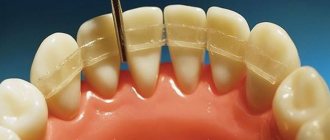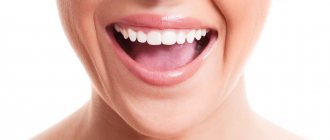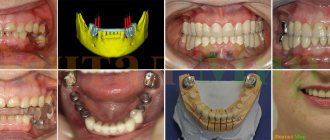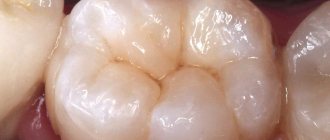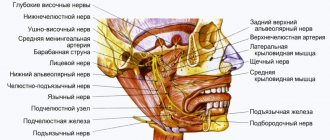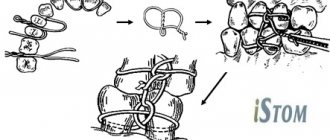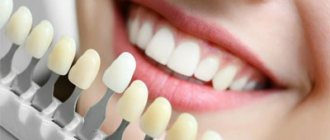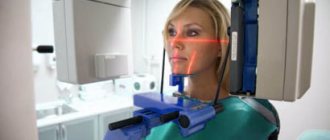16811
Malocclusion is a fairly common phenomenon that can be confidently interpreted as a diagnosis.
These are not only external defects of the maxillofacial apparatus, but also pathologies that cause certain harm to human health.
At the same time, there are often cases when the harm goes beyond the dental framework - difficulty chewing food leads to dysfunction of the gastric system.
One of these bite deviations is a pronounced defect in the development of the jaw. It manifests itself both in its size and in insufficient width or fragmented crowding of the dentition.
Definition
The concept of “small lower jaw” in orthodontics is not clearly defined.
This diagnosis is classified into several types, differing in the clinical picture of the anomaly.
Micrognathia
Mandibular micrognathia is a defective or too long-term development of an organ that goes beyond the norm.
The defect can affect both the entire jaw and its individual areas, for example, affecting only one lateral part.
Prognathia
It is considered a phenomenon directly opposite to the case described above.
The organ corresponds to the normal parameters, but with the pronounced size of the upper jaw, it seems that it is too small.
Experts often call this disease false prognathia.
Where do teeth come from?
Teeth begin to form and develop when the fetus is still inside the womb (at about 6 weeks). They have their source - the epithelial dental plate. Already by 14 weeks, active formation of dental tissues, which are hard, occurs. Initially, this occurs in the area where the crown will be, and later at the root.
Molars, namely their first rudiments, appear by the 5th month of the embryo. They are located higher than the child’s baby teeth or lower. By the time the child is born, the rudiments are already practically formed in the tissues of the jaw.
Teeth that belong to an additional group (have no predecessors) are formed later. This occurs after about 1 year of life. Why? Because the baby's jaw is still very small and there is not enough space for them.
Signs
The main sign indicating the presence of this disease is the visual observability of an anomaly - such a defect is visible to the naked eye, and you do not need to be a specialist in orthodontics to determine such a deviation in a person.
In addition, pathology deforms the natural proportions of the maxillofacial apparatus. The chin becomes sharp and slightly raised upward. Doctors even defined this phenomenon as “bird beard.”
It is important to understand that this is not just a cosmetic defect; micrognathia threatens its “owner” with the development of the pathology of tongue retraction, which is considered a serious disease.
The anomaly causes frequent uncontrollable attacks of suffocation and poses a serious threat to the patient's life.
The disease is often diagnosed based on this characteristic feature - excessive retraction of the chin leads to wrinkling of the skin in its area, and the horizontal fold between the chin and lip is smoothed out.
In addition, underdevelopment of the lower jaw often goes hand in hand with chromosomal mutation processes, which leads to Patau syndrome.
A clear sign indicating the presence of this defect is also the incorrect location of individual fragments of the dentition.
In the case when some organs are missing, neighboring teeth change the direction of growth, trying to spontaneously fill the free space.
What to do when teeth grow in two rows
With “shark” jaws, the most reasonable solution seems to be the removal of excess milk units. And they did this for a long time. The result of hasty decisions showed that hasty removal of primary incisors and fangs leads to the opposite result and the formation of a malocclusion. After this, pediatric dental surgeons began to see children only as prescribed by the orthodontist - after professional consultation with a specialist.
An orthodontist is the first doctor you should go to when teeth grow in two rows. The doctor will assess the prospects for the formation of the dentition, send you for an x-ray to accurately determine the rudiments of permanent teeth and make the right decision. And this will not always be immediate removal of a baby tooth!
Based on the results of the diagnosis and examination, the orthodontist can advise:
- increase the amount of solid food in the child’s menu - provide the missing pressure on the baby tooth, causing it to loosen and fall out;
- wait for the natural change of teeth so that the permanent unit moves into its intended place under the influence of other teeth and under the pressure of the tongue muscles;
- remove primary incisors and canines to forcefully free up space.
The latter purpose is typical for parallel growing teeth and firmly standing primary units, since this is the only case when there are no natural prerequisites for root resorption and normal bite changes.
Causes
This type of anomaly can be triggered by the following factors, some of which are external, and some are internal:
- unbalanced diet of a woman during pregnancy - in this situation, the defect is formed already at the stage of intrauterine development of the fetus;
- chromosomal mutations that cause deviations in the normal growth and development of the baby during pregnancy;
- genetic predisposition;
- Robin's syndrome is a congenital anomaly of the anatomical structure of the facial apparatus;
- too early loss of baby teeth or permanent organs in adulthood , as well as a fairly long change from a temporary bite to a permanent one;
- difficulty breathing through the nose , associated with the structure of the nasal septum or chronic diseases of the nasopharynx;
- mechanical organ injury.
Everything about correct orthognathic occlusion, its signs and characteristics.
Let's talk here about the treatment of dental dystopia.
Follow the link https://orto-info.ru/zubocheliustnye-anomalii/okklyuzii/glubokiy-prikus.html if you are interested in methods of treating deep bites in adults and children.
Milk teeth in children: structure, quantity, timing of eruption
Teeth (deciduous and permanent) are bone formations. They are designed to carry out the process of mechanical processing of food, the so-called mastication, in order to prepare it for subsequent digestion.
As for the anatomical structure of baby teeth, it is in many ways similar to the structure of adult teeth, although there are some important differences.
The part of the tooth located above the gum is called the crown. The surfaces of the crowns can be of different shapes depending on which particular tooth we are talking about, but in any case, in baby teeth they are much smaller in size.
The crown is connected to the root through a neck - a slightly narrowed part, around which connective fibers are located in the horizontal plane, forming the so-called circular ligament.
The root itself is located in a small depression called the alveolus. Vessels that supply nutrition to the tooth and nerves pass through a special hole in the apex of the root. Most people are mistaken in believing that baby teeth do not have roots. In fact, those of them that are intended for chewing food (molars) are also molars, only their roots are independently absorbed by the time they are replaced by permanent ones.
What is inside the crown? A photo of the structure of a baby tooth helps you find out:
- Any milk tooth, like a permanent one, is covered with enamel.
Only in temporary teeth it is much thinner and softer, and not so mineralized, which is why in children caries develops rapidly and can turn into pulpitis or periodontitis in a few weeks.
- Beneath the enamel is dentin, which is also much thinner than in permanent teeth.
This is the highly mineralized underlying tissue surrounding the tooth cavity and root canal. It is slightly inferior in strength to enamel. Dentin in the direction from the center is completely pierced by special tubules, through which impulses are transmitted and all metabolic processes occur.
- Dentin, closer to the root system, covers cement, to which the fibers of the ligamentous apparatus - periodontium - are attached.
- The internal cavity of the crown and root of the tooth is filled with pulp - very soft internal tissue in which nerves and blood vessels are located.
It plays a major role in providing the tooth with nutrients and carrying out metabolic processes. When the pulp is removed, metabolic processes in the tooth become impossible.
In baby teeth, the volume of the pulp is much larger, and the root tubules are wider than in permanent teeth.
In addition to the structural features of baby teeth, parents are concerned about the timing of their eruption and how many teeth should be normal at a given age of the baby. Let's look at these questions in more detail.
Treatment
Methods for eliminating micrognathia depend on the degree of development of the pathology, the age of the patient and can be gentle or radical.
In the first case, treatment is carried out gradually through the use of special bite-leveling structures, and in the second, surgeons are involved in the work.
In children
In childhood, this deviation is easy and in most cases, successfully, treated mainly with therapeutic methods, and with rare exceptions, surgically:
- sanitation of the oral cavity – complete restoration of damaged tooth segments, as well as removal of affected root areas. Restoring the integrity of periodontal tissues using general and targeted spectrum agents;
- pediatric prosthetics – indicated for early loss of mammary organs. The voids are filled by splinting or attaching temporary devices that maintain the correct position of growing teeth and correct the size of the jaw arch;
- correction of language function and normalization of the respiratory system - in the first case, this is surgical cutting of the frenulum, which is done quickly and almost painlessly. In the second - surgical alignment of the partitions, followed by rehabilitation exercises;
- myogymnastics – tonic effect on the muscle tissue of the organ through special gymnastic exercises.
It is advisable to carry out with children 4–6 years of age, when in case of underdeveloped pathology this method can be used as the main method of treating the defect.With positive dynamics, the need for subsequent installation of orthopedic structures, as a rule, no longer arises;
- leveling the unevenness of the chewing surface using the method of grinding (fissures) - an ideal solution for a slight deviation in jaw closure;
- the use of leveling systems and structures is carried out when the anomaly is too pronounced, when other correction methods are ineffective. Wearing mouth guards and plates, and in infancy special nipples, gradually brings the deviation back to normal.
In adults
Treatment of patients whose bite has already been formed takes longer, and methods for correcting it are most often more radical.
Bone grafting
The essence of the method comes down to artificial extension using a graft. Bone tissue is taken from other areas of the patient’s tissue, which guarantees good survival of the material.
Fixation of the grafted fragments is carried out using screws made of high-quality, durable alloy of titanium components. This is done as follows:
- the lower organ is incised;
- the hard tissue is moved apart and the osteoplast is immersed inside;
- fixed with screws;
- intermediate voids are filled with special plastic chips;
- implantation of the membrane and suturing of the organ.
The main advantages of the method are the rapid survival rate and reliability of the procedure; the jaw augmented in this way retains its functionality for many years.
Disadvantage: individual intolerance to components and osteoplast fixatives.
In the video, watch the process of bone grafting for anomalies of the lower jaw.
Bone grafting plus liposculpture
Plastic surgery of hard bone tissue is carried out similarly to the option described above, with the difference that in parallel, aspiration of the local accumulation of fatty tissue is carried out using a vacuum method.
The technique qualitatively solves the aesthetic problem of underdeveloped chin caused by this pathology, corrects its shape, evens out the oval of the face and, in a sense, resembles the effect obtained from lifting the chin area.
The advantage is a high aesthetic result, the disadvantage is the high cost of the procedure and the presence of a large number of contraindications to its implementation.
Causes of open bite development and its dangerous consequences.
In this article we will discuss treatment methods for microdentia.
At this address https://orto-info.ru/zubocheliustnye-anomalii/ryadov/suzhenie.html we offer details about the treatment of narrowing of the dentition.
Endoprosthetics
It is made with harmless facial implants from non-biological components - silicone, porous polyethylene or cartilage extract. The desired shape is given to the device directly during the operation.
The implant is inserted through deep incisions in the mucous cavity, which leaves no postoperative traces. The product is inserted into the subperiosteum in lateral fragments into the chin area and attached to it with surgical sutures to fix its position.
The disadvantage of this method is the rather long recovery period.
Lipofilling
This option is considered to be a non-surgical correction, which is its main advantage.
The method allows you to give the chin the desired shape through pinpoint needle injection of fat cells into the subcutaneous area, in those areas where an increase in the size of the chin is required.
The entire procedure takes no more than an hour. The rehabilitation period passes quickly and without complications. The only drawback is that 30% of the implanted tissue fragments are rejected by the body, which requires repeated lipofilling 5-6 months after the first procedure.
To learn how chin augmentation is performed using lipofilling, watch the video.
An integrated approach to the treatment of dental anomalies in children aged 9 to 13 years
One of the common reasons for the formation of complexes in children and adolescents is the unsatisfactory appearance of the smile and teeth. Children are known to be especially cruel to each other. And a child/teenager who does not stand out favorably from his environment often becomes the subject of ridicule from his peers. And if many imperfections can be successfully hidden, then problems with the visible part of the teeth and smile are quite difficult to disguise. As a result, children withdraw from society and withdraw into themselves. Acquired disorders of facial expression and articulation appear.
I want to share with you the story of one orthodontic treatment, where I had to act as a doctor, psychologist and teacher.
Patient A. born 2004. came to me for consultation at the age of 9 years.
Diagnosis: narrowing of the upper and lower jaw, crowded position of the teeth on the upper and lower jaw in the frontal area, palatal position of 1.2 teeth, multiple caries, poor oral hygiene (photo 1).
Initially, professional hygiene and sanitation were carried out, as well as training in the rules of brushing teeth at home.
Then a removable plate apparatus was made for the upper jaw with bite pads in the area of the lateral teeth, a spring-shaped point for 1.2 teeth, an expanding screw and a vestibular arch.
The use of the device lasted 2.5 months, until tooth 1.2 was removed from the block and the upper jaw was slightly expanded (photo 2).
The device was lost and an unplanned break of several months followed, but then we still managed to continue working. Treatment of caries of 1.6 and 4.6 teeth was carried out. Installation of a conditionally removable Quad Helyx device (photo 3). Activation for expansion and smooth derotation of molars.
It is also worth noting that the success of treatment in the first stages was overshadowed by the patient’s low responsibility regarding hygiene and the inability of parents to attend follow-up examinations in a timely manner. I had to do active psychological and pedagogical work in order to move on to the further stage of treatment with the brace system. And 6 - 7 months later, after fixing the Quad Helyx, a ligature bracket system was installed (photos 4, 5).
In this case, a non-standard (even slightly contradictory) treatment tactic was used. Already at the leveling stage, opening springs were connected with thin arcs in the area of 1.4 - 1.2 teeth and 4.2 - 4.4 teeth to create space for teeth 1.3 and 4.3, respectively (photo 6).
Next, a “window” was created on the mucosa in the projection of the crown of 1.3 teeth - a small “temporary” bracket was glued (as an alternative to an orthodontic button) and a weak extrusion traction was connected (photo 7).
As the permanent teeth erupted, they were also included in the brace system and smoothly placed in the dental arch (photos 7, 8, 9, 10). During each appointment, I noted the same poor hygiene and continued to carry out psychological work. I had to repeatedly “threaten” to stop treatment. But responsibility for the aesthetic future of the young patient’s smile did not allow me to do this.
After normalizing the position of all teeth and creating adequate occlusion, a joint decision was made to stop orthodontic treatment so as not to aggravate the condition of the already weakened enamel.
Next, remove the bracket system, grind and polish the surface of the teeth, manufacture and fixation of permanent retainers to areas 1.3 - 2.3 and 3.3 - 4.3 teeth (photo 11, 12, 13).
Of course, as you can see, there are still areas that would ideally require orthodontic correction. But personally, I think that this result can be considered acceptable and satisfactory. The result is a beautiful smile, complete aesthetic rehabilitation, psychological stability and hints at normalizing hygiene. Ahead is a course of remineralizing therapy, quality control of oral hygiene, and replacement of failed fillings. And today there is a brilliant smile of a confident young man (photo 14).
Prices
The approximate cost of treating a defect of abnormal development of the lower jaw is given in the table:
| Character of the bite | Correction method | Average price (in rubles) |
| Lactic | Sanitation of the oral cavity | From 3 500 |
| Lactic | Orthopedic therapy | From 30 000 |
| Lactic | Fissure grinding | From 11 000 |
| Lactic | Operation | From 15 000 |
| Constant | Bone grafting | From 19 000 |
| Constant | Bone grafting pole liposculpture | From 50 000 |
| Constant | Endoprosthetics | From 40 000 |
| Constant | Lipofilign | From 35 000 |
Features of the period.
By the age of 9, the child’s upper and lower incisors and first permanent molars erupt in the child’s dentition. The dentition still contains primary canines and molars. The permanent incisors are normally positioned evenly in the dentition without “protrusion” or “sagging” to the side.
By the age of 10, the process of formation of the roots of permanent teeth that have already erupted in the oral cavity (first molar, central and lateral incisors) is completed. These teeth are “stabilized” in the bone tissue.
At 9–10 years of age, the roots of the 4th milk tooth (1st primary molar) are reabsorbed and replaced with the 4th permanent tooth (1st premolar) first on the upper and then on the lower jaw. From 10 to 12 years of age, the roots of the 5th primary tooth (2nd primary molar) and primary canine begin to be reabsorbed and replaced by the 2nd premolar and permanent canine, respectively. The permanent canine is the last one to erupt.
By the age of 12–13 years, the replacement of baby teeth with permanent teeth is completed. There should be 24 teeth in the dentition: 12 on each jaw.
The child is 9 years old: his upper and lower permanent central and lateral incisors and first molars have erupted. The milk chewing teeth and fangs are still motionless, although the resorption of their roots has already begun.
Prevention
In some cases, the development of such a defect can be completely avoided by following the following recommendations:
- preference should be given to breastfeeding , and if this is not possible, control the hole on the nipple - it should not be large in size;
- it is necessary to choose the right pacifier so that its position does not put constant pressure on the weak bone tissue of the gums;
- timely treatment of dental diseases.
What should you consider when removing a baby tooth?
The following are taken into account:
- Anatomical features. The walls of primary teeth are relatively thin, and the roots can go deep at a large angle. Therefore, their removal requires the use of special forceps, which help eliminate the possibility of damage to the tooth walls. Pulling out is done in one motion so that the baby experiences minimal discomfort.
- Pain relief. In most cases, anesthesia is not required, especially if the tooth is already loose. Local anesthesia may be required to remove the nerve. The required dose of the drug is calculated individually for each patient.
- Contraindications to the procedure are diseases that cause bleeding disorders (leukemia, hemophilia), hematomas in the mouth, chicken pox, whooping cough, scarlet fever, influenza, sore throat, etc. Gingivitis and candidiasis can also be a reason to temporarily postpone the procedure.

